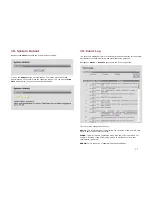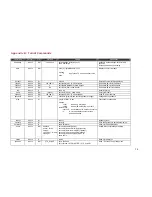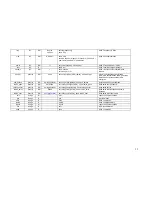
12
Key fields for this screen include:
Master / Slave MAC: The RF port MAC address of the Master and Slave unit.
Link State: Green if a link is established and Red if not.
Local RSSI: Receive Signal Strength as received by unit currently being
managed. For reliable link operation, RSSI should be a minimum of 6-10 dB
above the radio’s receive sensitivity.
Total Frames: Total number of aggregated RF data frames received and sent
by the unit. Note: this number should not be expected to match the Ethernet
frames count. Packet framing, aggregation and QoS operations will all affect
the manner in which data is transported from Ethernet to RF port.
Data Packets: Total number of data packets prior to aggregation, on the
transmit side, and following de-aggregation, on the receive side.
Receive Errors: Total number of errored frames received by the local unit.
Note: RF Frames which are significantly damaged can not be accurately
attributed to a paired radio and will not affect this count.
Transmit Errors: Total number of frames transmitted by the local radio that
were not successfully acknowledged by the remote radio.
Errors of this type can be attributed to two causes: (a) Data packet not
received by remote radio, or (b) Acknowledgement packet not received by local
radio.
It is often instructive to compare RX and TX error counts so that RF
impairments can be isolated to the appropriate link direction and radio.
11. Quality of Service (QoS)
For the transport of real-time data, such as VoIP or streaming video, a QoS
system provides end-to-end prioritization of pre-tagged Ethernet frames.
The QoS system relies upon the originating network device/appliance to tag
frames using an 802.1p VLAN priority tag
As a frame enters the Radio, a line speed tag inspection is performed and
frames are prioritized as follows:
a. A priority queuing method assigns tagged frames to one of the 4 priority
queues, allowing higher priority data to then be pushed onto the RF stack
ahead of lower priority frames. Tagged frames are assigned to queues
based on the following tag matrix:
Voice
Video
Normal Background
Tag
Method
802.1p
0x3
0x2
0x0
0x1
0x7
0x6
0x4
0x5
b. Once on the RF stack, the RF MAC gives prioritized frames early access to
the ‘air’ resulting in the frames being delivered sooner to the receiving
radio.
Notes:
•
The QoS system does not add or alter priority tags
•
QoS is always ‘enabled.’
•
For best results, all network devices (switches, routers, gateways)
between source and destination devices should be QoS aware.










































